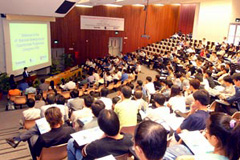
Nanyang Technological University (NTU) is a research-intensive university with globally acknowledged strengths in science and engineering. The university has roots that go back to 1955 when Nanyang University was set up. Today, NTU has four colleges with 12 schools, and three autonomous entities, the National Institute of Education, the S Rajaratnam School of International Studies, and the Earth Observatory of Singapore.
NTU provides a high-quality global education to more than 23,000 undergraduates and 10,000 graduate students. The student body includes top scholars and international olympiad medallists from the region and beyond.
Hailing from 72 countries, the university's 3,000-strong teaching and research staff bring dynamic international perspectives and years of solid industry experience.
NTU provides a high-quality global education to more than 23,000 undergraduates and 10,000 graduate students. The student body includes top scholars and international olympiad medallists from the region and beyond.
Hailing from 72 countries, the university's 3,000-strong teaching and research staff bring dynamic international perspectives and years of solid industry experience.


Centre for Excellence in Learning and Teaching
The Centre for Excellence in Learning and Teaching (CELT) supports Nanyang Technological University (NTU) in the key functions of teaching, research and publication. We manage the edveNTUre (Blackboard) eLearning portal as well as provide a wide range of services for staff and faculty on a job request basis.
The Centre for Excellence in Learning and Teaching (CELT) supports Nanyang Technological University (NTU) in the key functions of teaching, research and publication. We manage the edveNTUre (Blackboard) eLearning portal as well as provide a wide range of services for staff and faculty on a job request basis.
Our Mission
To advance the quality of educational development to significantly enhance student learning and professional teaching in the community. Our Vision
The Centre will be known as a provider of choice with a national and international reputation for leadership in advancing the development of blended learning in higher education.